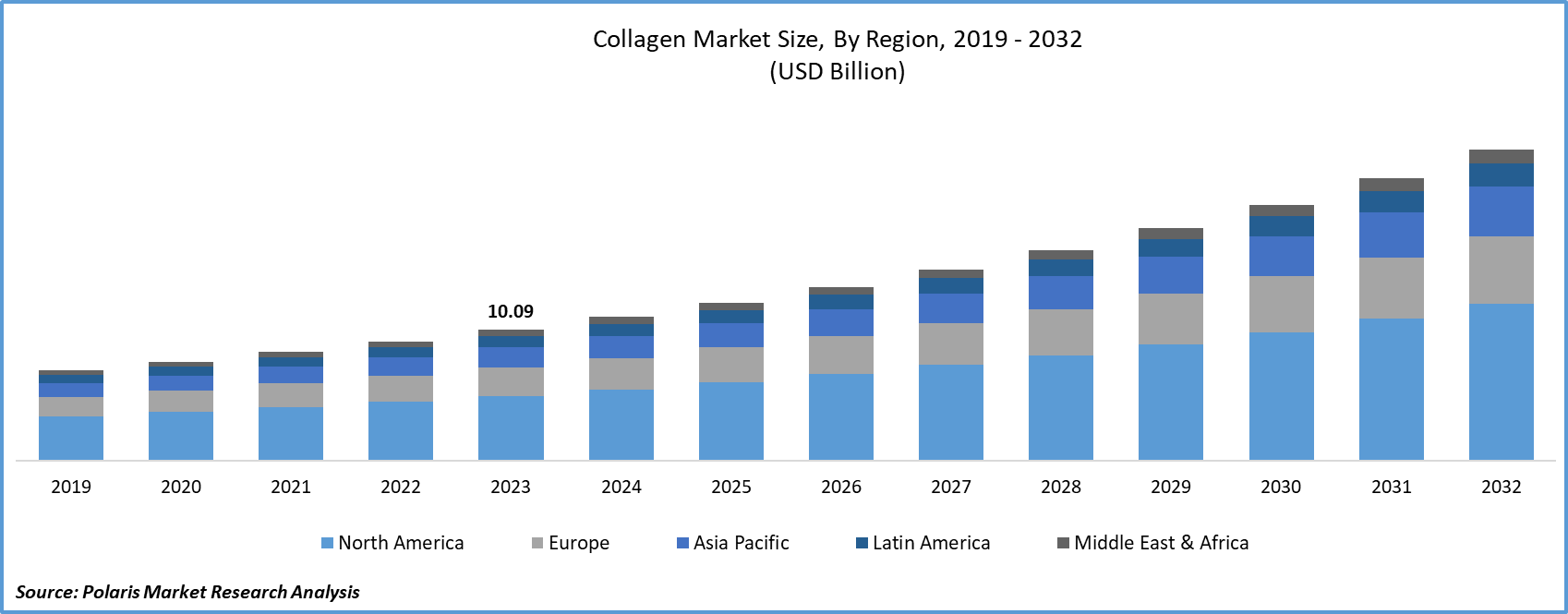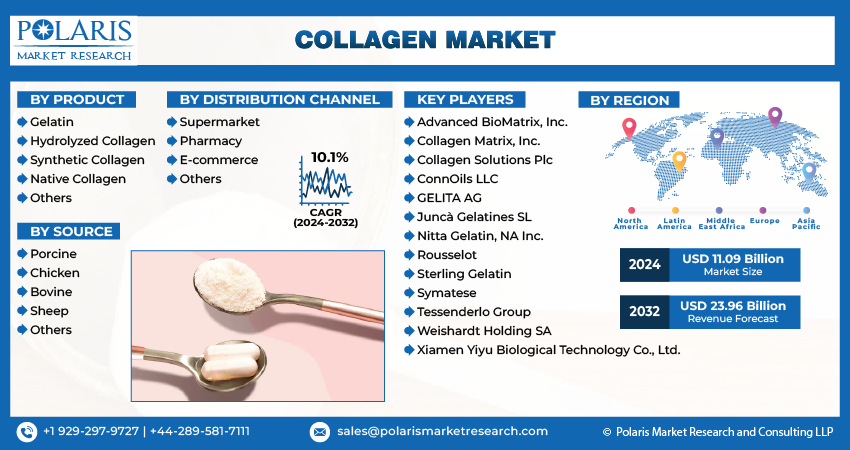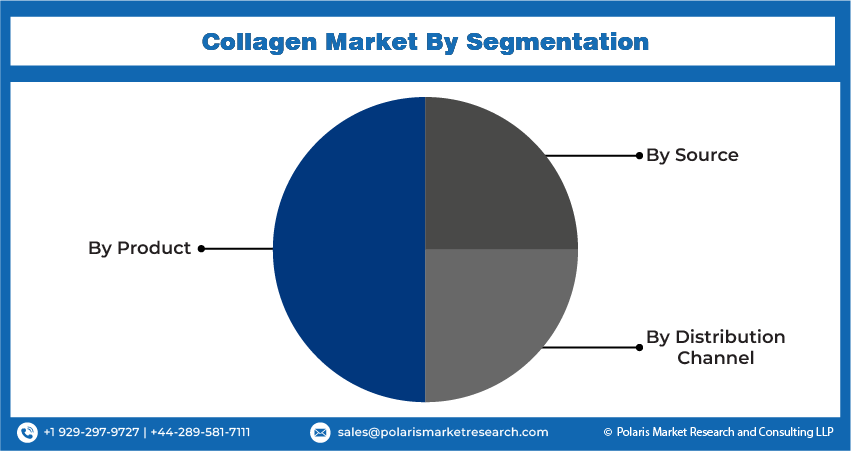
Collagen Market Share, Size, Trends, Industry Analysis Report, By Product; By Source; By Distribution Channel; By Region; Segment Forecast, 2024 - 2032
- Published Date:Jan-2024
- Pages: 117
- Format: PDF
- Report ID: PM4288
- Base Year: 2023
- Historical Data: 2019 – 2022
Report Outlook
Collagen Market size was valued at USD 10.09 billion in 2023. The market is anticipated to grow from USD 10.09 billion in 2023 to USD 23.96 billion by 2032, exhibiting a CAGR of 10.1% during the forecast period
Collagen Market Overview
The increasing leaning toward protein and nutricosmetics consumption, surging utilization of collagen in the food industry, and the rising use of collagen-based biomaterials are the pivotal factors driving the growth of the collagen market.
Collagen is a protein that naturally occurs in the body and has various applications in medicine due to its versatility. It is obtained through an industrial process from the bones, skin, cartilage, tendons, and tissues of animals like bovine, pigs, poultry, and marine species. Collagen is abundant in bones, muscles, and blood, accounting for three-quarters of the skin and one-third of the body's total protein.
Its synthesis requires amino acids like glycine, hydroxyproline, and arginine. Collagen has many benefits, such as improving brain health, preventing bone loss, reducing joint pain, increasing muscle mass, promoting hair and nail growth, and enhancing skin strength and elasticity. When compared to other proteins, collagen is predominantly insoluble. Its synthesis is facilitated by glycerine, arginine, and amino acids. Collagen promotes brain cell function and significantly contributes to maintaining bone health by preventing tissue loss. Additionally, it alleviates joint pains by reducing friction between bones during various movements.
The collagen market is growing mainly due to increasing industrial activity, which requires process improvements. Additionally, there is a growing need for functional ingredients in food, and the use of BSE-free bovine collagen in medical applications is contributing to this trend. A surge in demand for functional components in food products, lifestyle changes, the adoption of Western dietary habits, technological advancements, and an increase in research and development spending in regenerative medicine drives the market. Moreover, the market is positively influenced by the ever-increasing demand from vegan and vegetarian populations.
Collagen has become increasingly popular in the nutraceuticals industry and is extensively used in the production of dietary supplements and protein powders. This is due to the growing demand for dietary supplements and products that enhance physical strength and fitness. The regular consumption of collagen is associated with slowing down the aging process in the body because it is easy to digest. Manufacturers are introducing a wide range of collagen supplements in different flavors to cater to diverse preferences. Retail stores offer a vast selection of collagen supplements and powders, reflecting the extensive availability of these products. Collagen is also used in sports nutrition products to maintain joint and bone health.

To Understand More About this Research: Request a Free Sample Report
COVID-19 has had a substantial impact on the collagen market. Since the COVID-19 pandemic began, there has been a shortage of various protein-based nutrients on store shelves. Despite these challenges, the collagen market had a positive impact on the sales of vitamins and nutritional supplements, with a particular focus on immunity and health development. Due to the pandemic, people have become increasingly concerned about their health and immune systems, resulting in a significant increase in demand for collagen products.
Collagen Market Dynamics
Market Drivers
Increasing Consumer Preferences for Protein Supplements
Collagen is an excellent source of nutrients that offers a wide range of benefits, such as carbohydrates, calories, protein, fat, and fiber. As people become more conscious of their health, there has been a surge in demand for collagen supplements. This increased awareness has been a significant factor in driving the collagen market. According to research, in 2020, 31% of consumers in the United States increased their consumption of protein supplements, primarily to enhance their immune system. This trend is anticipated to continue to drive demand for collagen in the market throughout the forecast period.
The majority of collagen supplements that are available in the market are obtained from sources like porcine, bovine, and chicken. These supplements are often enriched with micronutrients like Vitamin A, Vitamin C, biotin, and zinc. Various collagen manufacturing companies are continually improving their formulations to incorporate essential nutrients that can prevent diseases and enhance the immune system of consumers. The ongoing advancements in collagen supplement development, combined with rapid progress in clinical nutrition, are the pivotal factors that are contributing to the growth of the collagen market.

Market Restraints
Risk Associated with Regulatory Challenges and Severe Side Effects Hamper on Growth of the Market
The collagen market faces significant risks due to regulatory challenges and severe side effects. Strict regulations and compliance requirements can cause delays in product approvals and market entry. Navigating the complex regulatory landscape requires significant investments in R&D and compliance measures, which may slow down the overall growth trajectory of the collagen market.
Report Segmentation
The market is primarily segmented based on product, source, distribution channel, and region.
|
By Product |
By Source |
By Distribution Channel |
By Region |
|
|
|
|
To Understand the Scope of this Report: Speak to Analyst
Collagen Market Segmental Analysis
By Product Analysis
The gelatin segment held the largest revenue share in the collagen market. It is widely used in the manufacture of cosmetics, ointments, medications, and edibles. Its popularity is on the rise due to increased consumer health consciousness. It is being increasingly used for its potential benefits in treating conditions such as osteoarthritis, osteoporosis, fragile nails, obesity, diarrhea, aging skin, and various other health conditions.
The hydrolyzed segment has witnessed the fastest growth in the market, owing to the surging consumption of health and beauty supplements. It assists in refining the texture and quality of nails, hair, and skin, along with strengthening bone and joint health. Additionally, it helps in surging the protein content in functional food, sports nutrition, and beverage products.
By Source Analysis
The bovine segment accounted for the highest market share in 2023, owing to the huge availability of cattle and lower prices. Bovine collagen is widely used in biomedical fields, including reconstructive surgery, cardiovascular treatments, and cosmetic and dermatological procedures. The benefits of bovine collagen include arthritis relief, skin health improvement, and bone loss prevention.
The chicken segment has witnessed the fastest growth in the market. Chicken collagen is extensively applied in the treatment of joint pain related to arthritis, neck pain, back pain, and other pain that occurs due to injuries. Also, chicken collagen consists of vitamin B9 or vital component folate, which assists in preventing heart disease.
By Distribution Channel Analysis
Based on the distribution channel analysis the market has been segmented on the basis of supermarket, pharmacy, e-commerce, others. The supermarket segment held the largest share of the market. Collagen supplements are mainly sold in supermarkets. To increase sales, they are purposively placed on stands and promoted through targeted retail advertising. These efforts effectively capture consumer interest. Supermarket shelves, product packaging, and promotional initiatives play a significant role in the growth of the collagen market.
The pharmacy segment has witnessed the fastest growth in the collagen market. Pharmacy distribution is a substantial factor in collagen supplement sales. Doctors' recommendations and prescriptions play a significant role in increasing collagen market sales. Additionally, effective merchandise presentation is critical in driving higher sales of collagen products.
Collagen Market Regional Insights
North America Dominated the Largest Market in 2023
North America dominated the market, The market is growing in North America owing to an increase in the elderly population and improved awareness of collagen products. Collagen is widely used in cosmetics, food and beverage, and healthcare industries. The introduction of collagen-infused gummy confectionery products is contributing to the increased demand for collagen in countries such as Canada and Mexico.
Asia Pacific has witnessed the fastest growth in the market. The demand for collagen in Asia Pacific is growing due to factors such as a burgeoning population, expanding healthcare services, and an increasing awareness of nutrition. Collagen is widely used in food processing to enhance shelf life and maintain nutritional value. Additionally, the growing elderly population in countries like Japan, India, and China is anticipated to contribute to the demand for collagen supplements for treating conditions like osteoarthritis.

Competitive Landscape
The market is characterized by intense competition, with established players relying on advanced technology, high-quality products, and a strong brand image to drive revenue growth. These companies employ various strategies such as research and development, mergers and acquisitions, and technological innovations to expand their product portfolios and maintain a competitive edge in the market.
Some of the major players operating in the global market include:
- Advanced BioMatrix, Inc.
- Collagen Matrix, Inc.
- Collagen Solutions Plc
- ConnOils LLC
- GELITA AG
- Juncà Gelatines SL
- Nitta Gelatin, NA Inc.
- Rousselot
- Sterling Gelatin
- Symatese
- Tessenderlo Group
- Weishardt Holding SA
- Xiamen Yiyu Biological Technology Co., Ltd.
Recent Developments
- In March 2023, Cambrium, a biotechnology company, launched its first product, NovaColl. NovaColl is a micro-molecular collagen that imitates the skin's natural composition exclusively for high-end personal care.
- In January 2023, The NIVIS Fibrillar Collagen Pack was launched by TELA Bio, Inc., a medical technology company with active commercial operations.
- In May 2022, MD Logic Health, a natural health and nutrition supplement manufacturing company based in the United States, has recently launched a new product known as Marine Collagen. This supplement contains a unique blend of co-factors, including vitamins A, C, zinc, copper, and biotin, along with hydrolyzed collagen types I, II, and III. The collagen in the supplement is obtained from non-genetically modified white fish.
- In May 2022, a U.S. based Collagen Powder manufacturing company named Vital Proteins LLC launched protein and collagen bars.
Report Coverage
The Collagen Market report emphasizes on key regions across the globe to provide better understanding of the product to the users. Also, the report provides market insights into recent developments, trends and analyzes the technologies that are gaining traction around the globe. Furthermore, the report covers in-depth qualitative analysis pertaining to various paradigm shifts associated with the transformation of these solutions.
The report provides detailed analysis of the market while focusing on various key aspects such as competitive analysis, product, source, distribution channel, and their futuristic growth opportunities.
Collagen Market Report Scope
|
Report Attributes |
Details |
|
Market size value in 2024 |
USD 11.09 billion |
|
Revenue forecast in 2032 |
USD 23.96 billion |
|
CAGR |
10.1% from 2024 – 2032 |
|
Base year |
2023 |
|
Historical data |
2019 – 2022 |
|
Forecast period |
2024 – 2032 |
|
Quantitative units |
Revenue in USD billion and CAGR from 2024 to 2032 |
|
Segments Covered |
By Product, By Source, By Distribution Channel, By Region |
|
Regional scope |
North America, Europe, Asia Pacific, Latin America, Middle East & Africa |
|
Customization |
Report customization as per your requirements with respect to countries, region, and segmentation |

